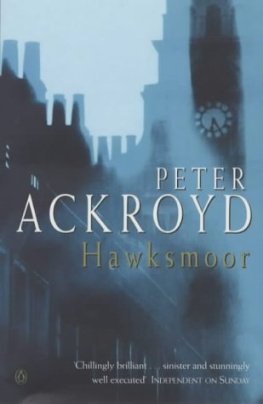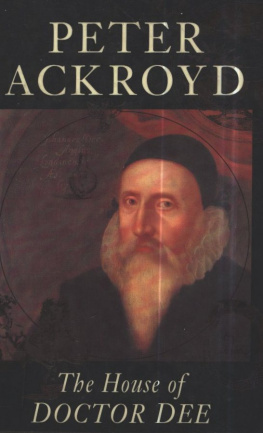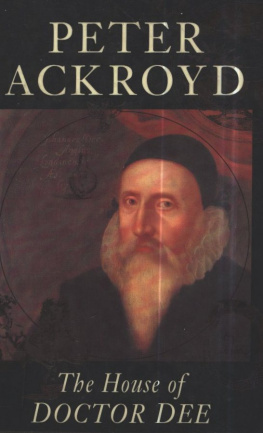Ackroyd - Hawksmoor
Here you can read online Ackroyd - Hawksmoor full text of the book (entire story) in english for free. Download pdf and epub, get meaning, cover and reviews about this ebook. City: London;England, year: 2010, publisher: Penguin Books Ltd (UK);Hamish Hamilton, genre: Detective and thriller. Description of the work, (preface) as well as reviews are available. Best literature library LitArk.com created for fans of good reading and offers a wide selection of genres:
Romance novel
Science fiction
Adventure
Detective
Science
History
Home and family
Prose
Art
Politics
Computer
Non-fiction
Religion
Business
Children
Humor
Choose a favorite category and find really read worthwhile books. Enjoy immersion in the world of imagination, feel the emotions of the characters or learn something new for yourself, make an fascinating discovery.
- Book:Hawksmoor
- Author:
- Publisher:Penguin Books Ltd (UK);Hamish Hamilton
- Genre:
- Year:2010
- City:London;England
- Rating:3 / 5
- Favourites:Add to favourites
- Your mark:
- 60
- 1
- 2
- 3
- 4
- 5
Hawksmoor: summary, description and annotation
We offer to read an annotation, description, summary or preface (depends on what the author of the book "Hawksmoor" wrote himself). If you haven't found the necessary information about the book — write in the comments, we will try to find it.
Ackroyd: author's other books
Who wrote Hawksmoor? Find out the surname, the name of the author of the book and a list of all author's works by series.
Hawksmoor — read online for free the complete book (whole text) full work
Below is the text of the book, divided by pages. System saving the place of the last page read, allows you to conveniently read the book "Hawksmoor" online for free, without having to search again every time where you left off. Put a bookmark, and you can go to the page where you finished reading at any time.
Font size:
Interval:
Bookmark:
In recent years serial killer novels and films have become something of a cliche. It's a genre which has been done to death with only a few works standing above the herd. So Hawksmoor was a very refreshing change. A novel set in London, with two threads, one in the 1800's and one in contemporary times. The novel opens in the period following the Great Fire of London, with one Nicholas Dyer, an assistant surveyor in scotland yard who eventually becomes an apprentice to Christopher Wren. He is commissioned to rebuilt the lost churches of London. In the present we are introduced to a series of characters, including a young boy and a vagrant, whose stories are painted with a lavish brush, before we meet the eponymous hero of the novel.
Hawksmoor is the detective investigating a series of serial killings, located in the vicinity of a number of churches across London. It is here that the various sub plots are brought together, the story centring on Hawksmoor attempts at unravelling the mystery.
All the while the story of Dyer's architectural plans and the rebuilding of London unravel simultaneously. His true character is gradually exposed, revealing unexpected connections between the two disparate storylines.
The conclusion of the novel is both unexpected and uncomfortable, a brilliant conclusion to a work with a great psychological presence. Ackroyd brings the personalities of his characters to the fore, places them in a lushly drawn backdrop, and shows the story through their eyes.
One of the most impressive things about the novel is the way Ackroyd treats the serial killer storyline, keeping it very much in the background, shown only through the eyes of the characters and the ensuing investigation. It never dominates the proceedings, and Ackroyd instead concentrates his energy on exploring the eighteenth century events that hold a key to the present day. It is both chilling and filled with an aura of corruption, a reinvention of history and a fresh look at the present through the eyes of history.
It has been a while since I have read a novel this satisfying, an enthralling story on all levels with an ending that stays with you long after you've finished it.
For Giles Gordon
Thus in 1711, the ninth year of the reign of Queen Anne, an Act of Parliament was passed to erect seven new Parish Churches in the Cities of London and Westminster, which commission was delivered to Her Majesty's Office of Works in Scotland Yard. And the time came when Nicholas Dyer, architect, began to construct a model of the first church. His colleagues would have employed a skilled joiner to complete such a task, but Dyer preferred to work with his own hands, carving square windows in miniature and cutting steps out of the clean deal: each element could be removed or taken to pieces, so that those of an enquiring temper were able to peer into the model and see the placing of its constituent parts. Dyer took his scale from the plans he had already drawn up and, as always, he used a small knife with a piece of frayed rope wrapped around its ivory handle. For three weeks he laboured over this wooden prototype and, as by stages he fitted the spire upon the tower, we may imagine the church itself rising in Spitalfields. But there were six other churches to be built also, and once again the architect took his short brass rule, his pair of compasses, and the thick paper which he used for his draughts. Dyer worked swiftly with only his assistant, Walter Pyne, for company while, on the other side of the great city, the masons shouted to each other as they hewed out of rough stone the vision of the architect. This is the vision we still see and yet now, for a moment, there is only his heavy breathing as he bends over his papers and the noise of the fire which suddenly flares up and throws deep shadows across the room.
AND SO let us beginne; and, as the Fabrick takes its Shape in front of you, alwaies keep the Structure intirely in Mind as you inscribe it. First, you must measure out or cast the Area in as exact a Manner as can be, and then you must draw the Plot and make the Scale. I have imparted to you the Principles of Terrour and Magnificence, for these you must represent in the due placing of Parts and Ornaments as well as in the Proportion of the several Orders: you see, Walter, how I take my Pen? And here, on another Sheet, calculate the positions and influences of the Celestiall Bodies and the Heavenly Orbs, so that you are not at a Loss on which Dayes to begin or to leave off your Labours. The Dsigne of the Worke, together with every several Partition and Opening, is to be drawne by straightedge and compass: as the Worke varies in rising, you must show how its Lines necessarily beare upon one another, like the Web which the Spider spins in a Closet; but, Walter, do this in black lead and not in inke -1 do not trust your Pen so far as yet.
At this Walter Pyne hangs down his Head in a sullen Manner, as if he was like to have been Whipp'd at the Cart's Tail, and I could not refrain my self from bursting out in Laughter. Walter was apt to be of a Morose and Sullen cast of Mind, and so to Cheer him I lean'd forward across the Table and gave him Inke readily-see, says I, what I will risk to keep you Merry? And now you are not so vex'd please continue: draw the erect elevation of this Structure in face or front, then the same object elevated upon the same draught and centre in all its optical Flexures. This you must distinguish from the Profile, which is signifyed by edging Stroaks and Contours without any of the solid finishing: thus a book begins with a frontispiece, then its Dedication, and then its Preface or Advertisement. And now we come to the Heart of our Dsigne: the art of Shaddowes you must know well, Walter, and you must be instructed how to Cast them with due Care. It is only the Darknesse that can give trew Formed to our Work and trew Perspective to our Fabrick, for there is no Light without Darknesse and no Substance without Shaddowe (and I turn this Thought over in my Mind: what Life is there which is not a Portmanteau of Shaddowes and Chimeras?). I build in the Day to bring News of the Night and of Sorrowe, I continued, and then I broke off for Walter's sake: No more of this now, I said, it is by the by. But you'll oblige me, Walter, to draw the Front pritty exact, this being for the Engraver to work from. And work trewe to my Design: that which is to last one thousand years is not to be praecipitated.
I had a violent Head-ach and, altho' there was only a small fire in the Closet, I was feeling unnaturall hot and walk'd out into Scotland-Yard; I knew that others imployed in the Office might stare at me, for I am an Object of Ridicule to them, and so I hasten'd my Steps to the Wood yards next the Wharfe where, since the Work men were at their Dinner, I might walk silent and unseen. This being the middle of Winter, and a strong Wind blown up, the River was pretty high for this spot and the Water was at times like to start a second Deluge while, on the Side opposite, the Feilds were quite darken'd as if in a Mist. And then of a sudden I could hear snatches of Song and confus'd Conversation; I whipp'd about, for in no wise could I ascertain where these Sounds came from, until I comforted my self with the Thought that it was the Wherry from Richmond which even then came into my View. So my Perceptions followed one another, and yet all this while my Thoughts were running on my seven Churches and were thus in quite another Time: like a Voyager I am confin'd in my Cabbin while yet dreaming of my Destination. And then, as I stand looking upon the River and the Feilds, I Blot them out with my Hand and see only the Lines upon my Palm.
I walk'd back to the Office, thinking to find Walter engag'd upon the Generall Plan and Upright, but I saw him lolling upon his Stool by the Chimney-Corner, gazing into the Fire as if he saw Strange Visions in the Coles and looking as melancholly as a Female Wretch does upon a Smith-Feild Pile. I trod softly to the Table and saw there one Draught half-made in inke and black lead. Well this is good for Nothing you impudent Rogue, said I, come here and see. And Walter in confusion rose from the Fire rubbing his Eyes, and would as like have rubb'd out his Face if he could. Look here Master Pyne, I continu'd, I do not like the jetting out of the Pillars after I instructed you to shew Pilasters there: and also here the Portal is near three feet out. Are you so wooden-headed that I must teach you Feet and Inches? Walter thrust his Hands into his Breeches and mutter'd so that I could not hear him.
Font size:
Interval:
Bookmark:
Similar books «Hawksmoor»
Look at similar books to Hawksmoor. We have selected literature similar in name and meaning in the hope of providing readers with more options to find new, interesting, not yet read works.
Discussion, reviews of the book Hawksmoor and just readers' own opinions. Leave your comments, write what you think about the work, its meaning or the main characters. Specify what exactly you liked and what you didn't like, and why you think so.














